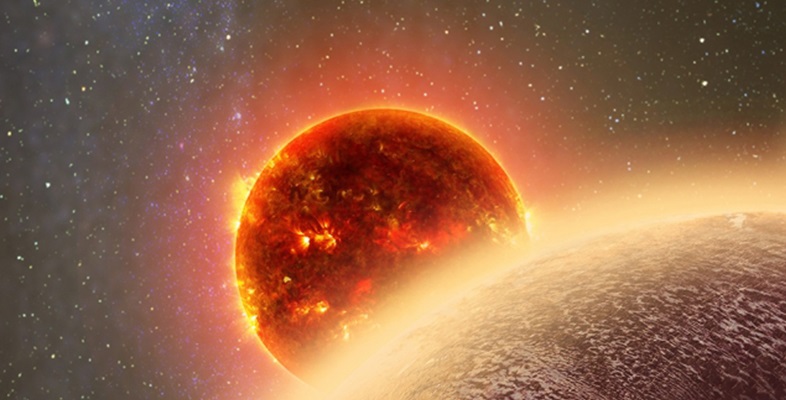8.4 Habitable planets around M dwarfs
Because M dwarf stars are dim, a planet in the habitable zone needs to be close to its star. This means that the orbital period of a potentially habitable M dwarf planet is much shorter than an Earth year.
Activity _unit7.8.1 Activity 8 The habitable zone of an M dwarf star
The interactive application above is the same as the one you used in Activity 6, but the range of values on each slider has been changed to allow you to focus on the lowest-mass stars. M dwarfs have masses up to about half the Sun’s mass. As before, it includes a greenhouse effect in the calculation of the planet’s surface temperature.
Adjust the stellar mass slider to 0.5 solar masses, representing one of the most massive M-type stars. Adjust the distance of the planet from the star until the planet surface temperature is about 300 K. You can also use the arrow keys on the keyboard to amend the values.
How long is the planet’s orbital period?
Answer
You should obtain an orbital period close to 0.17 Earth years.
How long is the planet’s orbital period in Earth days?
Answer
Multiplying by the number of days in an Earth year, this is equivalent to about 62 Earth days.
Even for the most massive, most luminous M-type star, and assuming a greenhouse effect, a planet in the habitable zone would be so close to its star that it completes an orbit in about two Earth months.
Adjust the stellar mass slider to 0.12 solar masses, representing Proxima Centauri, the Sun’s closest neighbouring star. It is a low-mass M-type star. Adjust the distance of the planet from the star until the planet surface temperature is about 300 K.
How long is the planet’s orbital period?
Answer
For 303 K, the orbital period is 0.023 Earth years.
How long is the planet’s orbital period in Earth days?
Answer
Multiplying by the number of days in an Earth year, this is equivalent to between eight and nine Earth days.
Activity 8 showed that for a low-mass M-type star like Proxima Centauri, a planet in the Goldilocks habitable zone would be so close to its star that it completes an orbit in not much more than an Earth week.
The proximity has another effect too: have you noticed that we only ever see one side of the Moon from Earth? This is because the Moon is so close to the Earth that it is forced by Earth’s gravity to keep the same face pointed at Earth. We say that it is ‘tidally locked’ – it doesn’t rotate on its own axis independently of the Earth. Its period of rotation is just the same as its orbital period around the Earth. This same gravitational effect between the Earth and the Moon causes the tides.
A planet in the habitable zone around an M dwarf star suffers the same tidal locking effect. The same side of the planet always points at the star it orbits around. This means the star is fixed in the planet’s sky. As time passes there is no cycle between day and night. Someone living on one of these planets would never see a sunrise or a sunset unless they travelled between the light and dark side of the planet.
So, the potentially habitable planets of M dwarf stars are quite different from Earth. They are cousins of our world, not twins. You’ll learn about how we hope to find Earth’s twins in Week 8.
